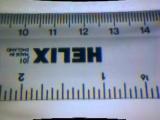

Length
 |
 |
| Most rulers have English units on one side (in.) and metric units on the other side (cm, mm). The top side of this ruler shows inches. Notice that 16 lines make up each inch. If an object measure 10 lines past 1 inch, the object is 1 10/16 inches long. You can reduce this measurement to 1 5/8 inches. | Now the top side of this ruler is showing metric units. Each large line with a number gives the number of centimeters, while every little line is a millimeter. You can count and see that there are 10 mm in a cm. If an object measures 9 lines in (1 line short of the 1), the object is 9 mm long. An object that measures two lines past the 1 is 1.2 cm long (1 cm and 2 mm). |
Mass
 |
 |
||||||||||||||
|
There are many ways to determine the mass of an object. We will use a triple beam balance.
It is similar to the scale they use in the doctor's office. In order to get an accurate
reading, move the weights on the three beams all the way over to zero. Place your object
on the tray on the balance. Start with the largest weight, the one in the back. Move it over
one spot to the right and make sure that it locks in place. If the pointer on the side opposite
the tray remains above the line, you can move the weight over one more place. Once the
pointer drops below the line, you need to move the weight back to the left one place. Then
repeat the procedure with the weight in the middle and then the weight in the front. You'll
have to continue to adjust the weight in the front until the pointer points exactly to
the line. Finally,
add together the readings for the three weights. If the back weight read 100 g, the middle one
10 grams, and the front one 4.2 grams, the mass of the object is 114.2 grams.
Volume
Temperature
| |||||||||||||||